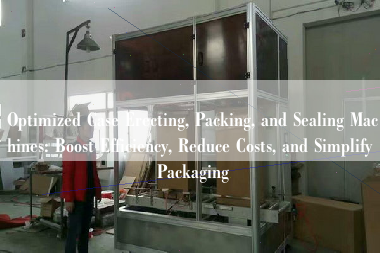Case Erecting, Packing, and Sealing Systems: Technology Overview & Core Selection Factors
Packaging efficiency forms the backbone of modern manufacturing. Yanmao Intelligent Equipment (Suzhou) delivers integrated case erecting, packing, and sealing solutions, transforming manual processes into streamlined, high-output operations. These systems handle diverse carton types, ensuring product integrity from formation to pallet staging.
Case Erectors, Packers, and Sealers: Core Functions & Industrial Applications
Case erectors automate the transformation of flat corrugated blanks into rigid cartons. Systems vary from simple manual-feed models to high-speed, automatic magazine-fed units. Case packers precisely load products – bottles, pouches, bags, or trays – into the erected cartons. Loading methods include robotic pick-and-place, continuous motion vertical loaders, or drop-in systems. Case sealers apply tape or glue to securely close filled cartons, featuring options like top/bottom sealers, side sealers, or “H” sealers for full closure integrity.
These machines find critical application across industries:
Food & Beverage: Securing bottles, cans, snack bags, and frozen goods within shipping cases.
Pharmaceuticals: Ensuring tamper-evident, secure closure for medicine boxes and kits.
Consumer Goods: Handling diverse products like cosmetics, electronics, and household items.
E-commerce Fulfillment: Managing high SKU variability and rapid carton size changes.
* Industrial Supplies: Packing tools, parts, and components into sturdy shipping containers.

Critical Selection Parameters: Throughput, Compatibility, Automation Level
Choosing the optimal system requires evaluating key performance indicators:
Throughput (Cases Per Minute – CPM): Match machine speed to upstream production lines. High-volume environments demand robust, continuous-motion equipment.
Carton Size & Style Compatibility: Define the range of carton dimensions (LxWxH) and styles (RSC, HSC, trays, etc.) the system must accommodate. Quick-change tooling minimizes downtime.
Product Handling Requirements: Consider product weight, fragility, orientation, and grouping needs. Packing method (top-load, end-load, wrap-around) impacts machine choice.
Automation Level: Options range from semi-automatic (operator presents product) to fully automatic integration with upstream conveyors and downstream palletizers. Robotic packing offers flexibility for complex patterns.
* Sealing Method: Select tape (hot melt, pressure-sensitive) or glue based on carton material, closure strength needs, and operational environment.
Addressing Industry-Specific Needs: E-commerce, Pharma, Precision Instruments
Specialized sectors impose unique demands:
E-commerce & Logistics: Systems require exceptional flexibility for frequent carton size changes, handling poly mailers alongside boxes, and integration with warehouse management systems (WMS). Print-and-apply labelers are often integrated.
Pharmaceuticals & Medical Devices: Compliance with GMP standards is essential. Designs prioritize cleanability (stainless steel surfaces), validation support, and reliable, tamper-evident sealing. Traceability features may be needed.
* Precision Instruments & Electronics: Equipment must minimize vibration and prevent static discharge (ESD-safe components). Gentle handling and secure internal packing are critical. Dust-free environments may require specific construction.
Sustainability & Operational Efficiency: Energy, Materials, Maintenance
Modern packaging automation incorporates sustainable design principles:
Energy Efficiency: Servo-driven motors significantly reduce power consumption compared to traditional pneumatic systems. Smart controls optimize energy use during idle periods.
Material Adaptability: Systems handle recycled-content corrugated board effectively and can be configured to minimize tape or glue usage without compromising seal integrity. Compatibility with lighter-weight board supports source reduction.
* Predictive Maintenance & Lifecycle Costs: Robust designs with accessible components simplify upkeep. Remote monitoring capabilities enable predictive maintenance, reducing unplanned downtime. Low-maintenance components and readily available spare parts lower long-term operational expenditures.
Market Economics & Procurement Decision Models for Case Erecting-Packing-Sealing Systems
Investment in automated packaging systems demands rigorous financial analysis. Yanmao’s integrated case handling solutions deliver quantifiable returns through operational efficiency gains and labor reduction. Understanding total cost structures and supplier evaluation frameworks ensures strategic capital allocation.
Total Lifecycle Cost Structure: Acquisition, Operation, Consumables
Comprehensive cost assessment extends beyond initial purchase price:
– Acquisition Costs: Capital expenditure covers equipment, installation, integration, and factory acceptance testing. Integrated systems often yield lower per-unit costs versus standalone machines.
– Operational Expenditures: Include energy consumption (servo vs. pneumatic systems), routine maintenance labor, and facility footprint requirements. Yanmao’s energy-efficient designs reduce power draw by 15-30% versus industry averages.
– Consumable Expenses: Correlate directly with throughput volumes. Tape/sealant usage, wear components (belts, bearings), and changeover parts constitute recurring costs. Systems optimizing material usage lower per-case expenses.
– Downtime Impact: Unplanned stoppages create hidden costs. Predictive maintenance capabilities and robust construction minimize production losses.
Price Gradient Determinants: Brand, Technology, Capacity
Market pricing reflects three core variables:
1. Brand Premium: Established manufacturers command 10-25% premiums for proven reliability, compliance certifications (ISO, CE), and global service networks.
2. Technical Configuration: Advanced features like robotic integration, vision-guided loading, or pharmaceutical-grade stainless steel construction increase costs 20-40%. Simpler semi-automatic systems offer entry-level pricing.
3. Throughput Capacity: High-speed systems (40+ CPM) require reinforced structures and precision components, escalating prices proportionally. Mid-range models (20-40 CPM) balance performance with affordability.
Supplier Evaluation Framework: Support, Supply Chain, Future-Proofing
Vendor selection requires multidimensional assessment:
– Technical Support Ecosystem: Evaluate response time guarantees, regional service coverage, and remote diagnostics capabilities. Yanmao maintains 24/7 multilingual support hubs in North America and Europe.
– Spare Parts Supply Chain: Verify inventory depth for critical components. Suppliers with regional warehouses ensure <48-hour delivery for 90% of wear parts.
– Upgrade Compatibility: Modular designs allow incremental automation enhancements. Assess controller architecture openness and mechanical interface standardization for future retrofits.
Procurement Decision Tree: CAPEX Optimization & Risk Mitigation
A structured approach navigates investment complexities:
1. CAPEX/OPEX Balance: Calculate payback periods comparing integrated solutions versus manual labor. Typical ROI horizons range from 18-36 months at 70% utilization.
2. ROI Calculation Methodology: Factor in labor savings ($/hour), throughput increases (cases/hour), material waste reduction (%), and quality improvement (reject rate reduction).
3. Technology Obsolescence Defense: Prioritize suppliers offering firmware update paths and backward-compatible hardware. Lease-to-own options mitigate rapid innovation cycles.
4. Risk Allocation: Warranties covering >95% uptime and performance guarantees protect against operational uncertainties. Third-party validation of throughput claims is advisable.
Intelligent procurement transforms packaging from cost center to competitive advantage. Data-driven decisions align automation investments with strategic production goals while containing financial exposure.
